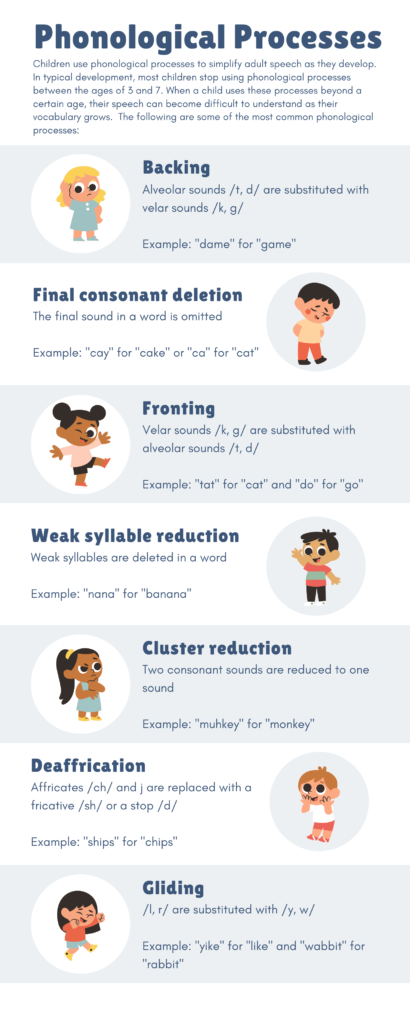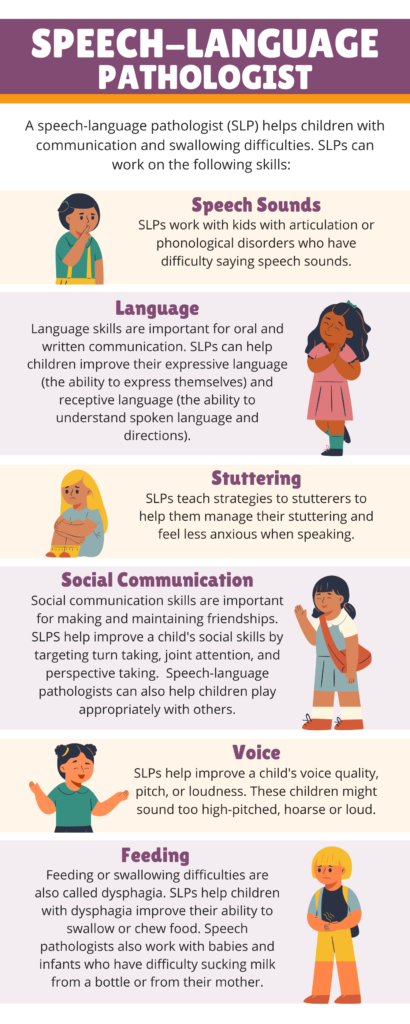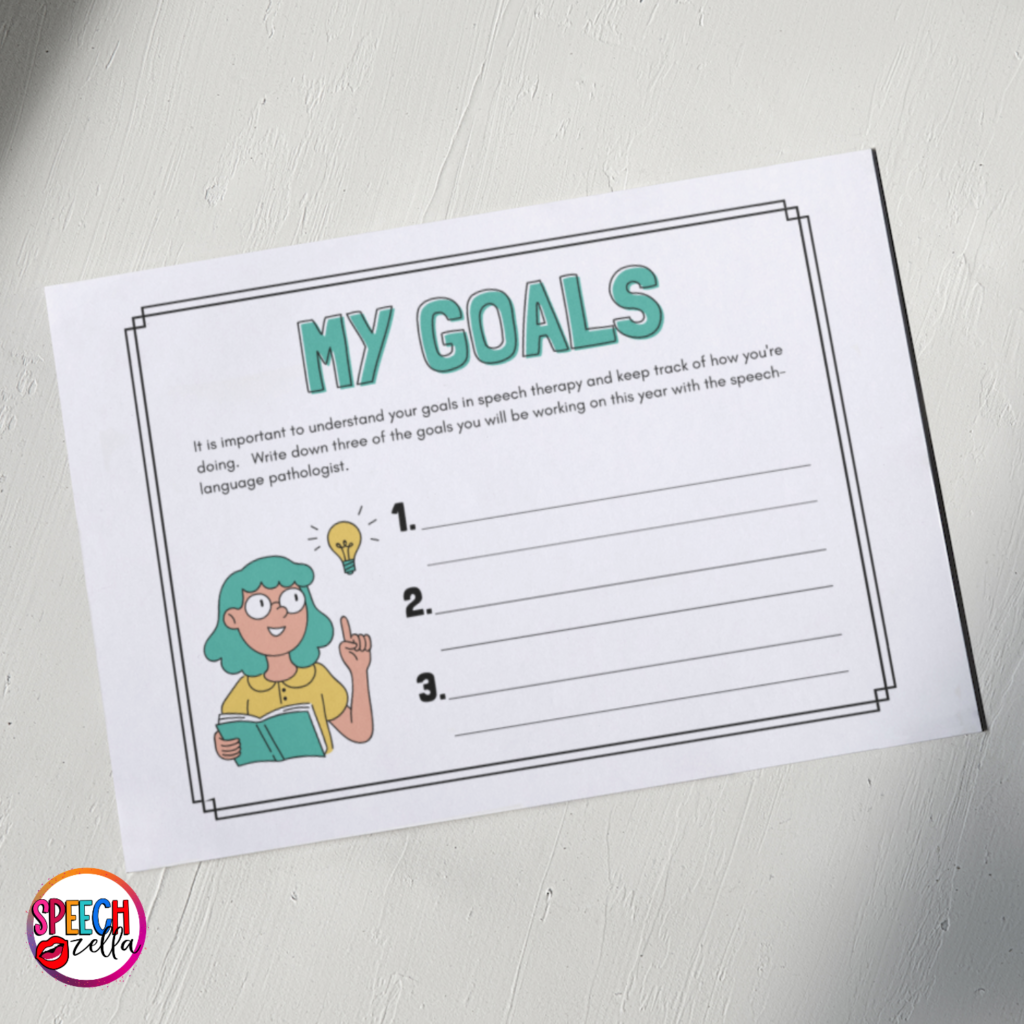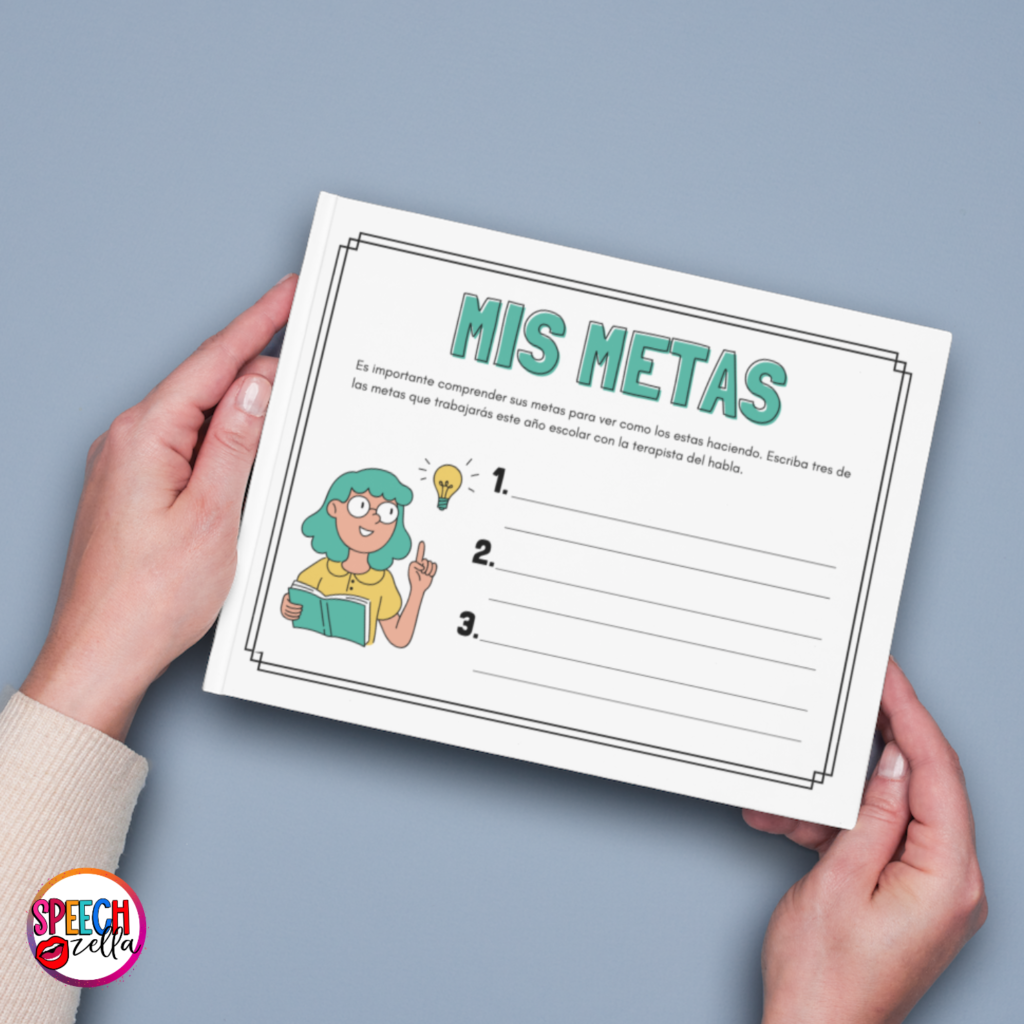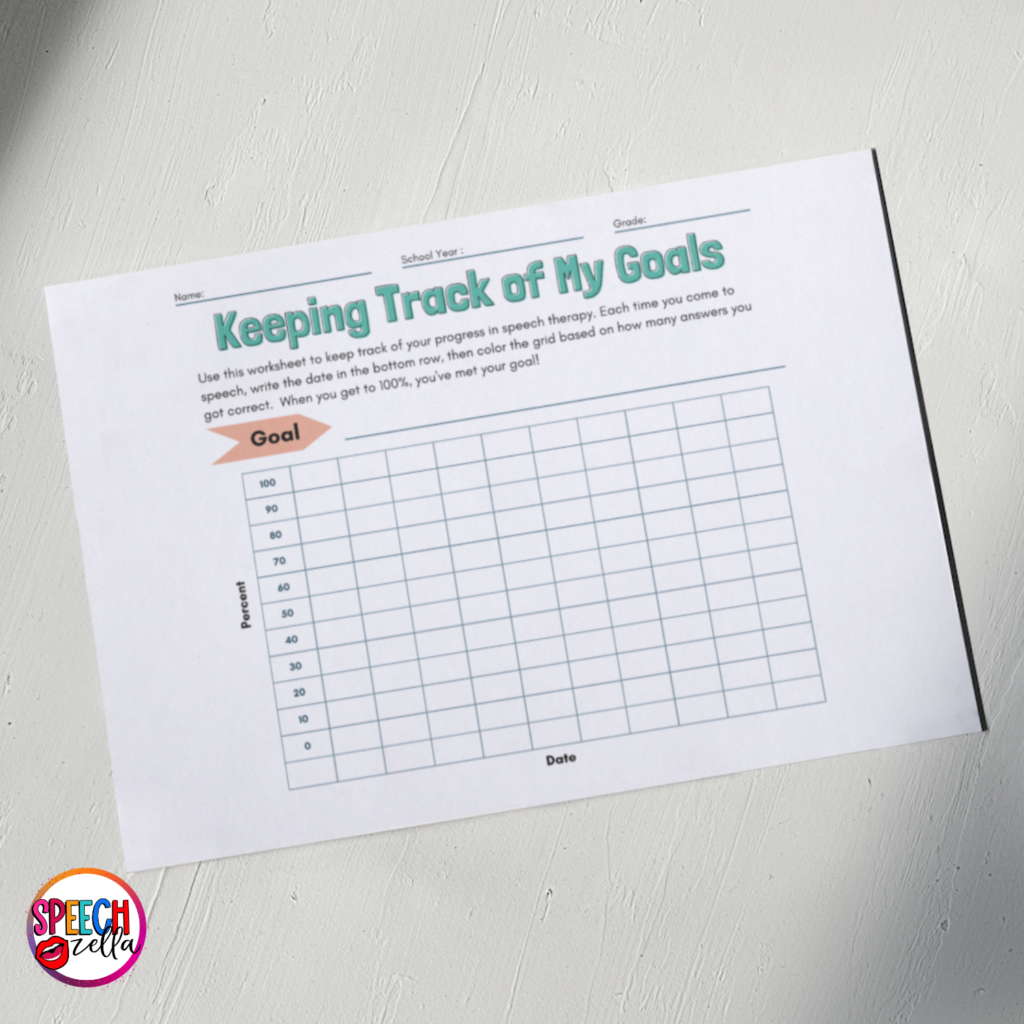Resources to Target Speech Therapy Goals and Objectives
Are you looking for free and editable resources to help your students measure their speech therapy goals? Canva has so many activities and worksheets that you can use to help your students understand, measure and track their goals. Keep reading till the end to get all the free templates to help your students understand their specific goals.
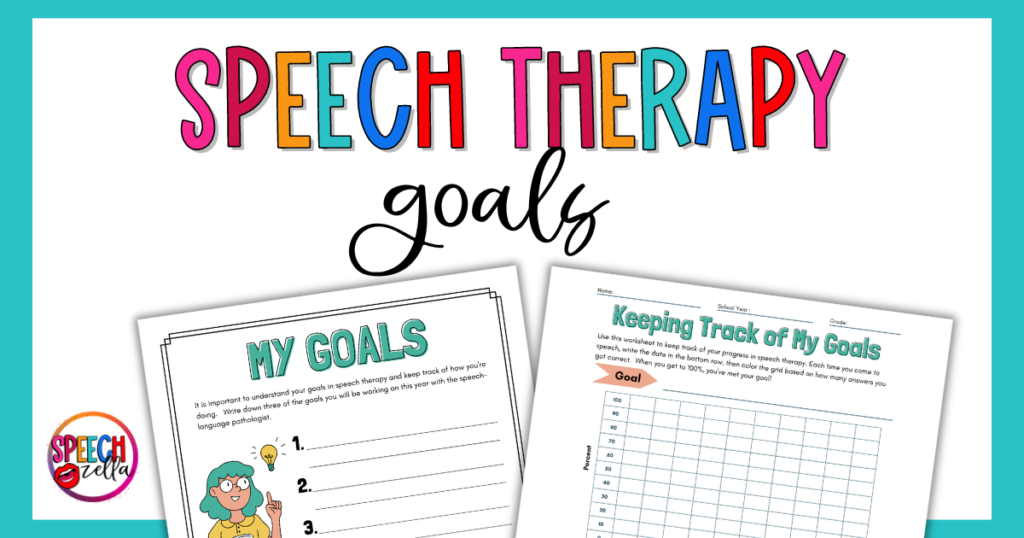
Target Speech and Language Goals with Canva
In Canva, speech-language pathologists can effortlessly create engaging materials, like flashcards, worksheets, and visual aids for your therapy sessions. There are a wide array of templates, customizable layouts, and images and graphics to target IEP goals. Whether you're targeting articulation or language, you can find fun and engaging helpful resources for your students. Conversely, here are some of the goals you can work on:
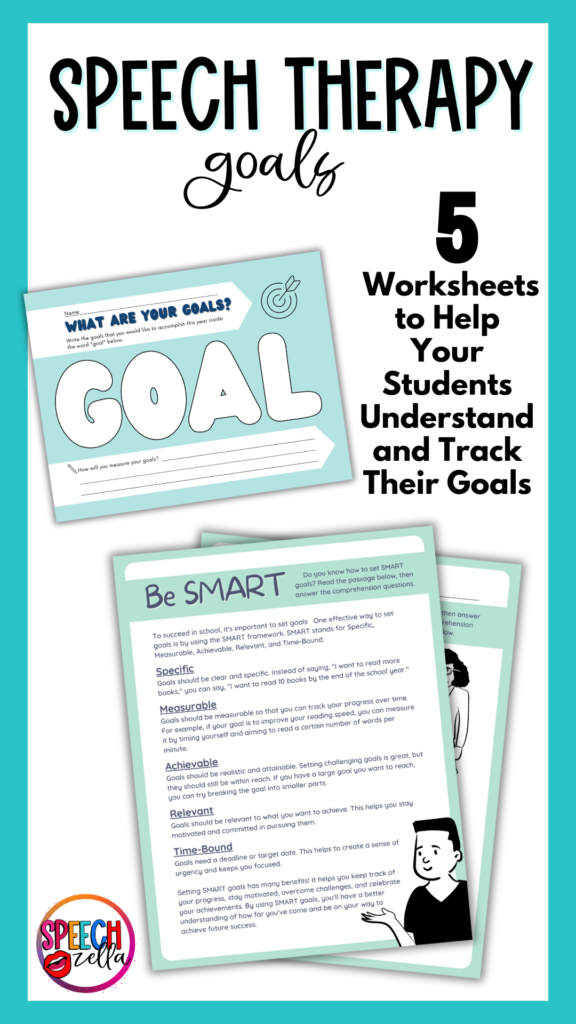
Vocabulary Speech Therapy Goals:
Vocabulary speech therapy goals are all about building up your student’s word bank and expanding their word knowledge. When your students have a limited vocabulary, it is harder for them to express themselves in complete sentences. You might hear them using word fillers (such as “uhm”) or use non-specific words (i.e., “this” and “that”). Improve their overall language skills by working on vocabulary.
Introduce new words through different activities such as reading aloud stories and books with rich vocabularies. You can try playing games that involve word recognition and categorization, or using flashcards to learn new words. You can also provide clear definitions and examples of how to use the new words in context.
Syntax Speech Therapy Goals:
Working on syntax with your students can help improve their sentence structure and grammar. When you use Canva to target syntax, you’ll help your students create more coherent sentences.
Semantics Speech Therapy Goals:
Semantic speech therapy goals are all about expanding understanding and expression related to the meanings of words – what they represent. This includes enhancing skills in word categories like nouns, verbs, and adjectives. Explore synonyms and antonyms so they can have a robust vocabulary.
You can also target figurative language, like metaphors and similes. This is a great way to unlock creative expression in writing. Explore analogies to strengthen logical reasoning. Overall, semantic speech therapy aims to foster comprehensive language skills and facilitate effective communication.
Expressive Language Speech Therapy Goals:
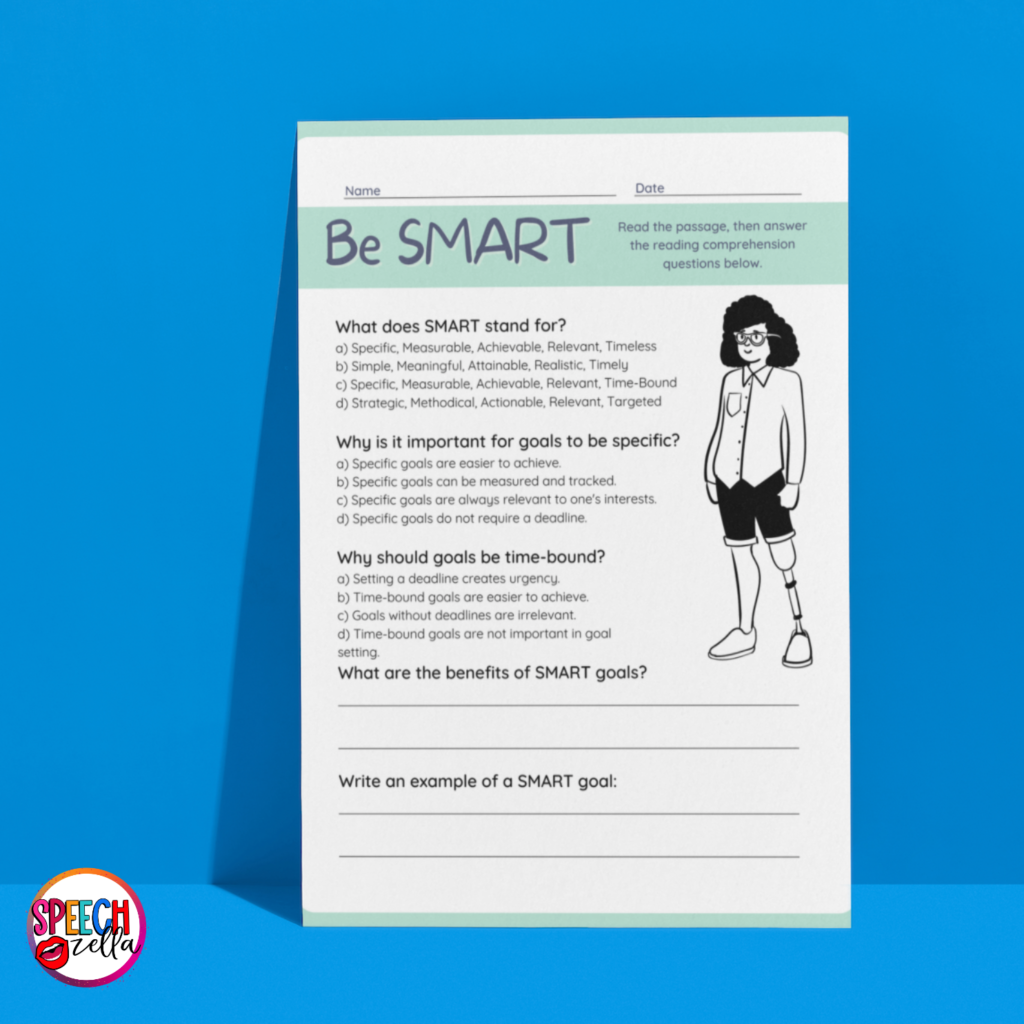
These goals help your students express their thoughts, feelings, and ideas clearly and effectively. Students working on expressive language skills might use simple sentences. When you target expressive language goals, you’ll expand your student’s vocabulary. You’ll also help them with using more descriptive language and forming grammatically correct sentences. By setting expressive language speech therapy goals, you’ll boost your student’s confidence and ability to communicate with their friends and teachers.
Receptive Language Speech Therapy Goals:
Listening is a key part of communication, and that's where receptive language speech therapy goals come in. These goals focus on improving your student’s ability to understand spoken language and follow instructions. If they’re struggling to process auditory information, target receptive language goals. This will make a big difference by boosting their overall communication skills.
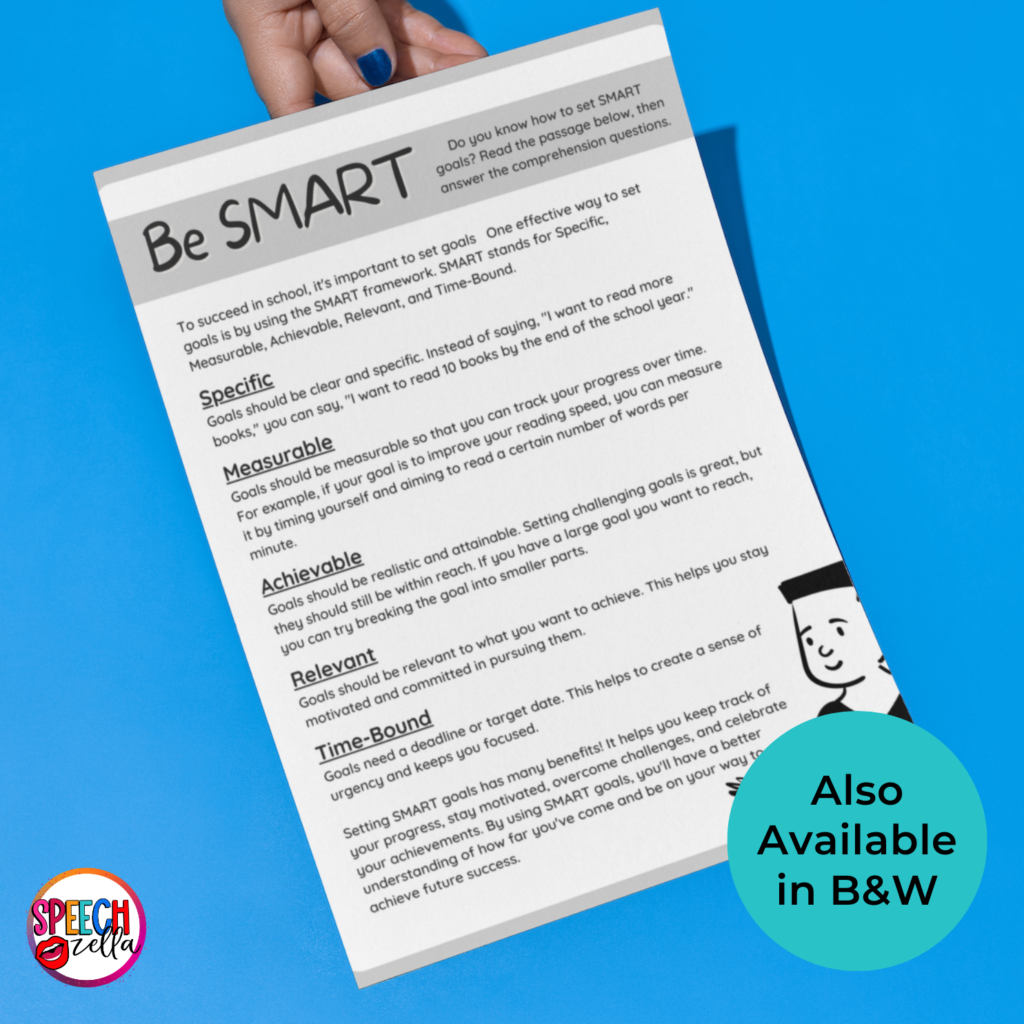
Pragmatic Speech Therapy Goals:
Pragmatic speech therapy goals include skills like turn-taking, initiating conversations, maintaining eye contact, joint attention, understanding body language, facial expressions, and using appropriate gestures. When you set pragmatic language goals, you can help your students through social interactions. Then, they will improve their conversational skills in social situations.
Articulation and Phonology Goals:
Did you know, you can target articulation goals and phonology goals in Canva…. Check out my other blog post “Free Vocalic R Worksheets for Articulation Therapy” to find out more!? With Canva, you can create a treatment plan, as well as visuals and interactive activities. This will help improve their articulation skills. There are tons of templates that target speech goals at the word level in Canva.
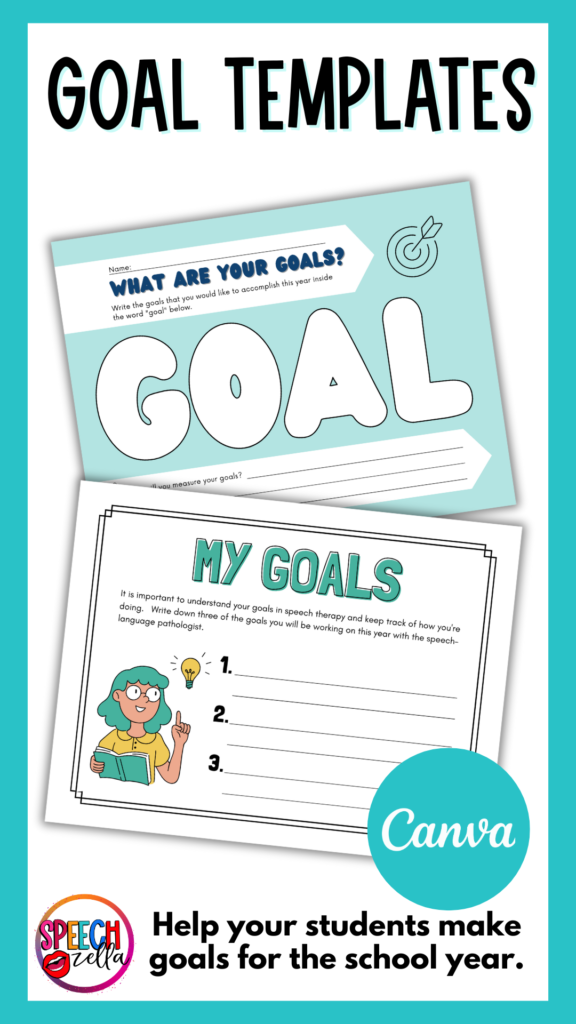
If you want to know more about specific goals that can be included in these areas, read below! If you want more, also leave a comment. I will create a blog post about sample goals you can use with your students that have specific needs.
Infographics for the Speech-Language Pathologist
To get more information about all of the different areas a speech therapist can target goals in a school setting, check out this infographic. It outlines which speech and language goals are commonly addressed. Hang up this infographic in your speech room or throughout your school!
Phonological Processes Infographic:
- This infographic includes information about the 7 most common phonological processes in speech therapy with examples. The following processes are currently on the infographic: backing, final consonant deletion, fronting, weak syllable reduction, cluster reduction, deaffrication, and gliding.
- You can edit this free template to include any other phonological processes that you feel should be included!
Speech-Language Pathologist Infographic:
- This speech infographic details some of the areas within the SLP's scope of practice with a brief description for each one.
- The following are the areas included in this infographic: articulation (speech sounds), language, fluency (stuttering), pragmatics (social communication), voice, and dysphagia (feeding).
- This infographic can be printed at home and placed in your office, school, or classroom to inform students and teachers about what you work on in therapy
Why is it important for students to understand their speech and language therapy goals?
It's so important for students to understand their goals in speech therapy! 🎯 When students understand their goals, they become engaged in therapy. This is the best way to make them feel in control and empowered. They will feel excited and will want to improve as much as possible. 🗣️💪
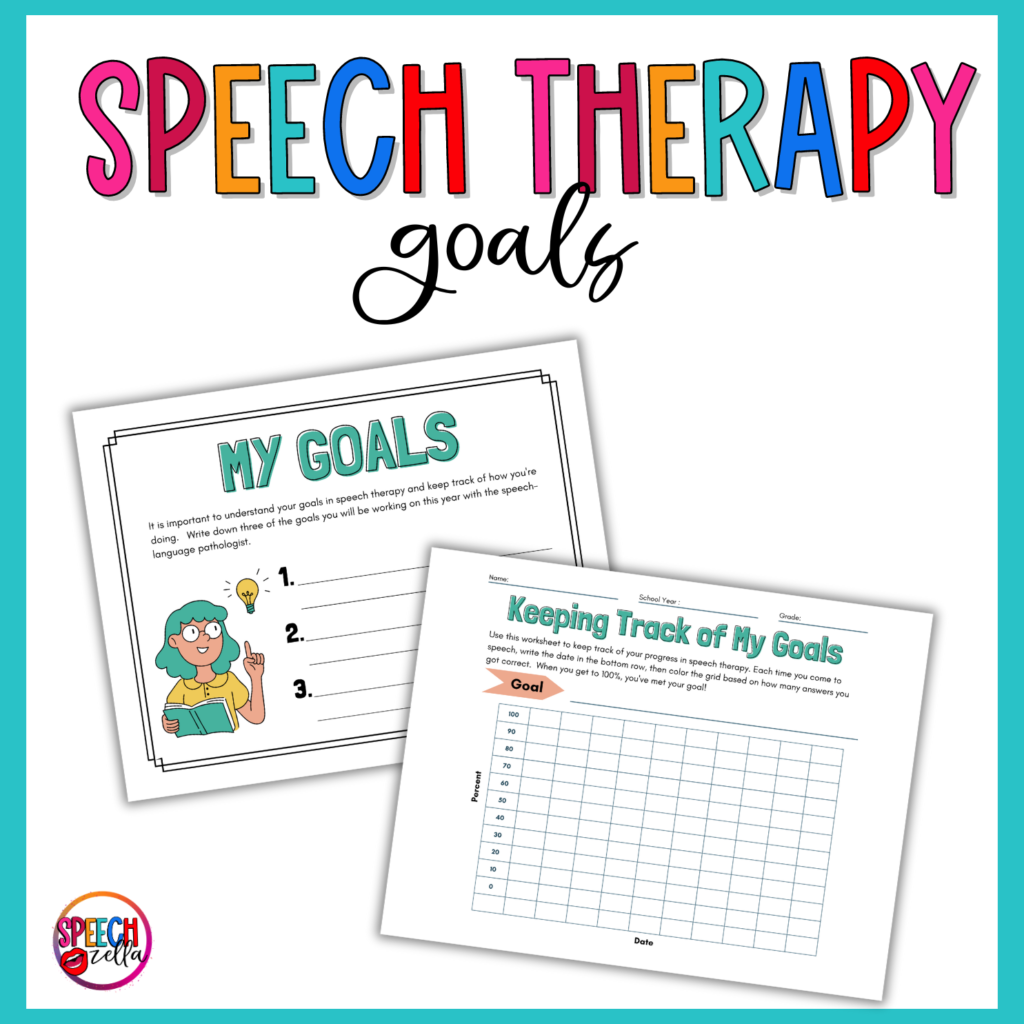
Which Canva Designs Can You Use to Track Goals?
Actually, there is good news! There are tons of Canva templates for speech therapists that can help your students understand their goals. Conveniently, you can download all of these resources into a printable PDF. Your next step is to look through this collection of templates:
Setting Goals Worksheet
This simple goal setting worksheet is a creative way to inspire your students to think about their goals. This template incorporates the word “GOAL,” and asks the student to write the goals they would like to accomplish inside of the word “GOAL”. Then, they'll have to write how exactly they will measure their goals. With this worksheet, students can:
- Brainstorm Goals: Generate ideas related to their desired outcomes.
- Reflect on Progress: Revisit the worksheet to review and reassess their goals periodically.
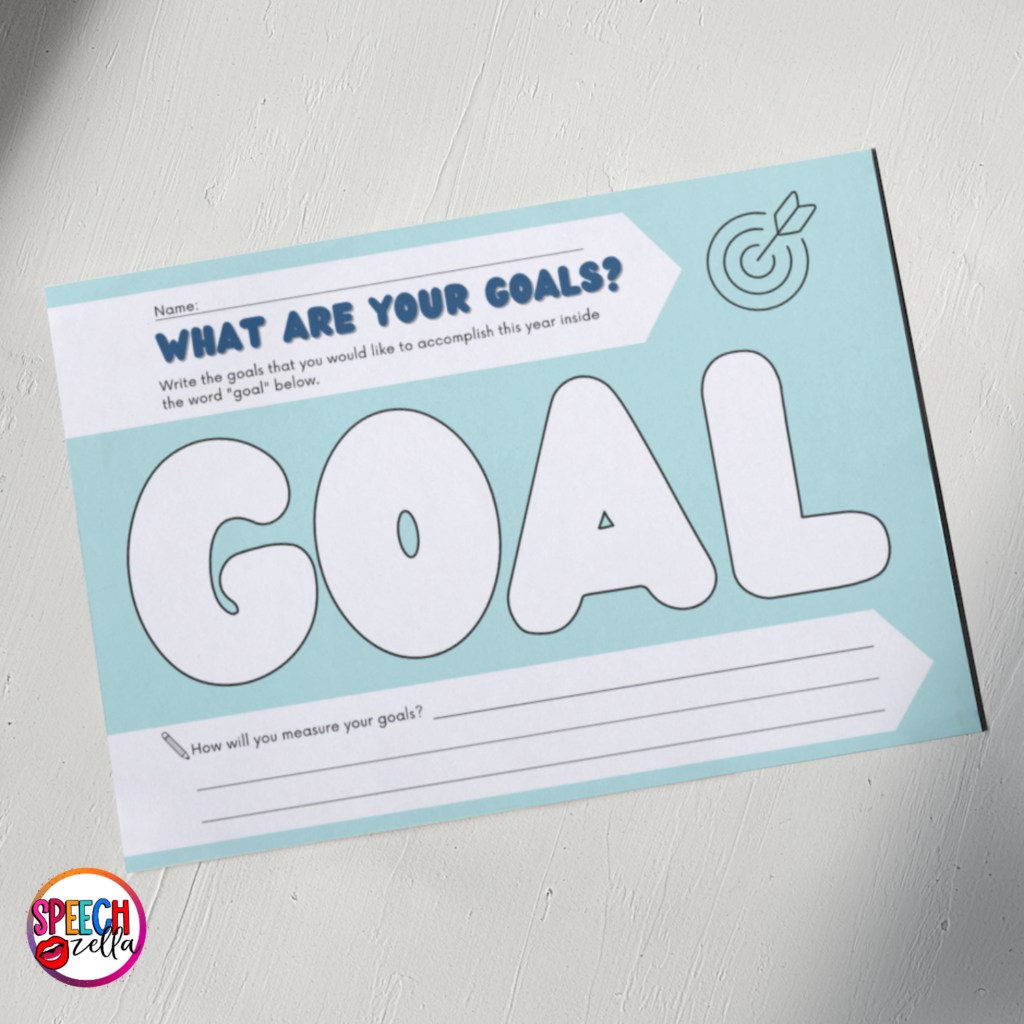
Goals for Speech Therapy Worksheet
Help your students own their progress with this Goals for Speech Therapy Worksheet. This template helps students identify their speech and language goals, which makes therapy sessions more engaging and student-driven. When students actively participate in setting their objectives, it fosters responsibility and motivation to smash them! 🎯 This template is available in both English and Spanish (for your ELL students!).
Keeping Track of My Speech Therapy Goals
Check out this awesome worksheet called “Keeping Track of My Goals“! It's super colorful and interactive, perfect for students in speech therapy. They can mark their progress by recording the date and coloring in squares based on correct answers. It's a fun way to visually track improvement. And once they hit 100%, they know they've crushed their goal! This worksheet not only looks cool but also motivates students to aim for bigger achievements. This template is available in both English and Spanish.
Speech Therapy Goals Punch Card
Here’s an alternative that works great for younger students up to the fourth grade. Younger students, especially, love positive reinforcement and rewards. The Goal Punch Card template on Canva makes tracking and rewarding progress super fun for your students. With this template, you can:
- Set Milestones: Define specific milestones towards the ultimate goal.
- Reward Achievements: Offer a new punch on the card whenever a milestone is reached.
- Boost Motivation: Encourage students to complete tasks to earn their rewards.
These Speech Therapy Goals Punch Cards are perfect for tracking goals in a fun and simple way. It's a great visual tool that helps students to stay on track with their goals. The punch card has boxes for them to mark off when they complete each goal. Each box represents a certain level of success, and once all the boxes are filled, they know they've achieved their goal! It also encourages students to aim higher and work towards bigger goals. This punch card is available in Canva for free!
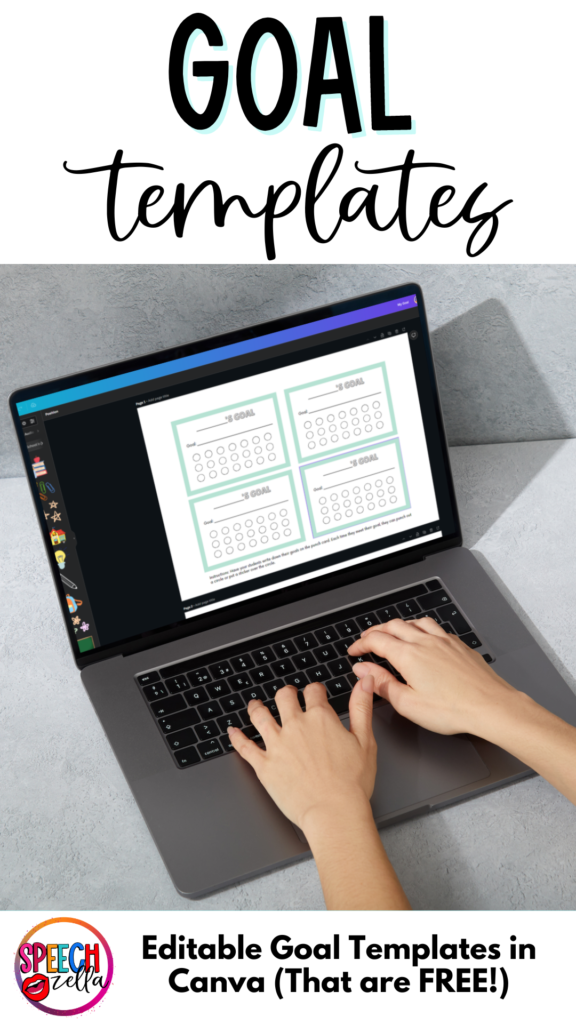
SMART Goal Setting Reading Comprehension Worksheet
SMART Goals Poster
Here is a handy poster that you can use with your high school and middle school students so they can understand what a SMART goal is.
What is a SMART goal?
A SMART goal is one that is Specific, Measurable, Achievable, Relevant, and Time-bound. These are the key elements that help in creating goals that are clear, well-defined, and actionable. By incorporating these attributes into your goal-setting process, you make it easier to track progress along the way. So, remember, when setting goals, be SMART! 😊
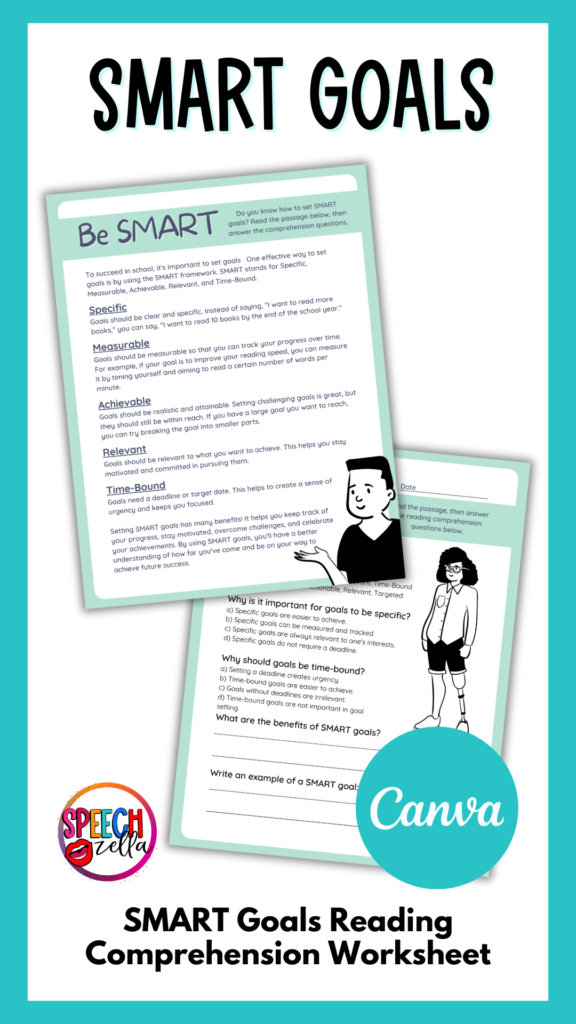
Now that you have downloaded the poster, it's time to have your students understand what a SMART goal is.
To begin with, this worksheet starts by explaining what a SMART goal is – Specific, Measurable, Achievable, Relevant, and Time-bound. The worksheet then walks them through the steps of writing their own SMART goal. It gives some examples to help students understand each step better as they work through it. At the end of the worksheet, there's space for reflection, encouraging students to evaluate their learning process and think critically. This worksheet is a fantastic tool to help students identify and achieve meaningful goals in their studies! Check it out today!
Here is a goal bank with some examples of SMART goals you can use in your speech room:
SMART Expressive Language Therapy Goals
- Within 3 months, the student will improve their use of descriptive language by incorporating at least three adjectives in each spoken sentence, at least 70% of the time. The student will be provided with moderate visual prompts, as measured during conversations with the speech pathologist.
- By the end of the quarter, the student will improve their expressive language skills by using conjunctions (i.e., and, but) to create compound sentences in a structured situation with minimal cueing, 60% of the time.
Receptive Language Therapy Goals
- By the end of the marking period, the student will improve receptive language skills by identifying 15 new words related to science at least 60% of the time when provided with minimal cueing, as measured by informal criterion-referenced tests created by the speech pathologist.
- Within 6 weeks, the student will improve their receptive language skills by following familiar single-step directions that do not include modifiers with at least 60% accuracy, as measured during unstructured situations in the speech therapy room.
- By the end of 4 months, the student will improve their receptive language skills by understanding and identifying correct responses to wh- questions (i.e., who, what, when, where), with 70% accuracy provided with moderate visual and verbal cueing and measured by a criterion-referenced informal assessment provided by the speech pathologist.
- By the end of the school year, the student will improve receptive language skills by using context clues to understand the meaning of unknown words in conversation. The student will attain at least 70% accuracy, as measured by informal assessments created by the speech pathologist.
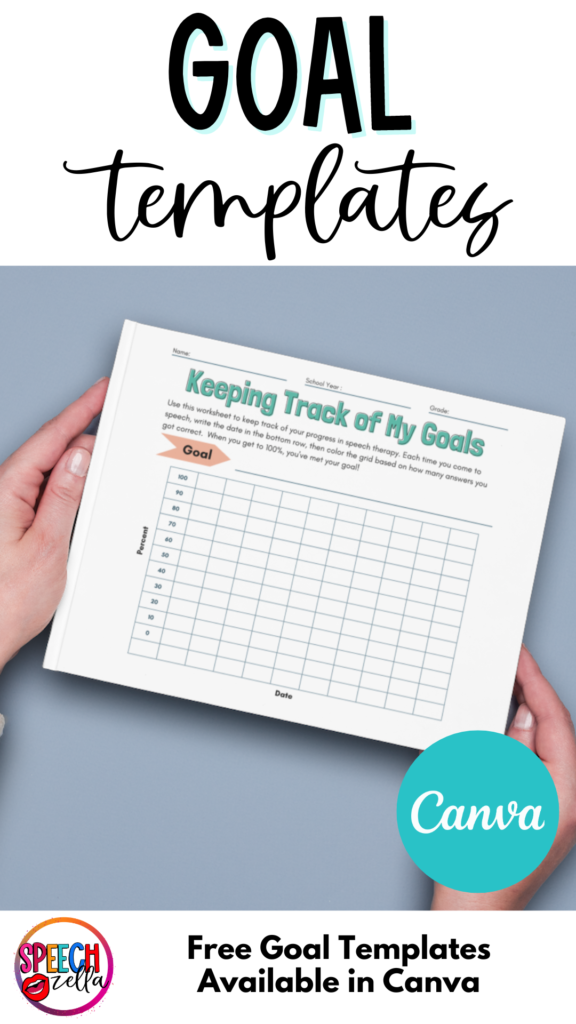
SMART Articulation Therapy Goals
- Within 6 weeks, the student will improve articulation skills by accurately producing the /r/ sound in the initial position of words with 80% accuracy. The student will be provided with visual cues by the speech pathologist in conversational speech.
- At the end of the marking period, the student will improve articulation skills by producing the /s/ sound in the final position of words in short sentences provided by the speech pathologist with 70% accuracy and a moderate visual and verbal cue.
Phonological Processes Therapy Goals:
- Within 6 months, the student will improve intelligibility by reducing the use of final consonant deletion at the word level in at least 80% of the target words presented by the speech pathologist when provided with moderate visual cues.
- At the end of the marking period, the student will improve intelligibility by reducing the use of consonant cluster reduction in the initial position of words with 70% accuracy when presented with picture cards and/or worksheets and given moderate cues.
SMART Pragmatic Language Therapy Goals:
- Within 3 months, the student will initiate at least three conversations with peers during recess or lunchtime to improve social communication skills, 40% of the time in unstructured conversations, as measured by their peer using a conversational skills rubric.
- By the end of the marking period, the student will improve social communication skills by taking turns independently, 80% of the time, as measured during a game in group therapy sessions.
- Within 3 months, the student will identify and label emotions in themselves and others in group therapy sessions with 70% accuracy, as measured by informal assessments provided by the speech pathologist.
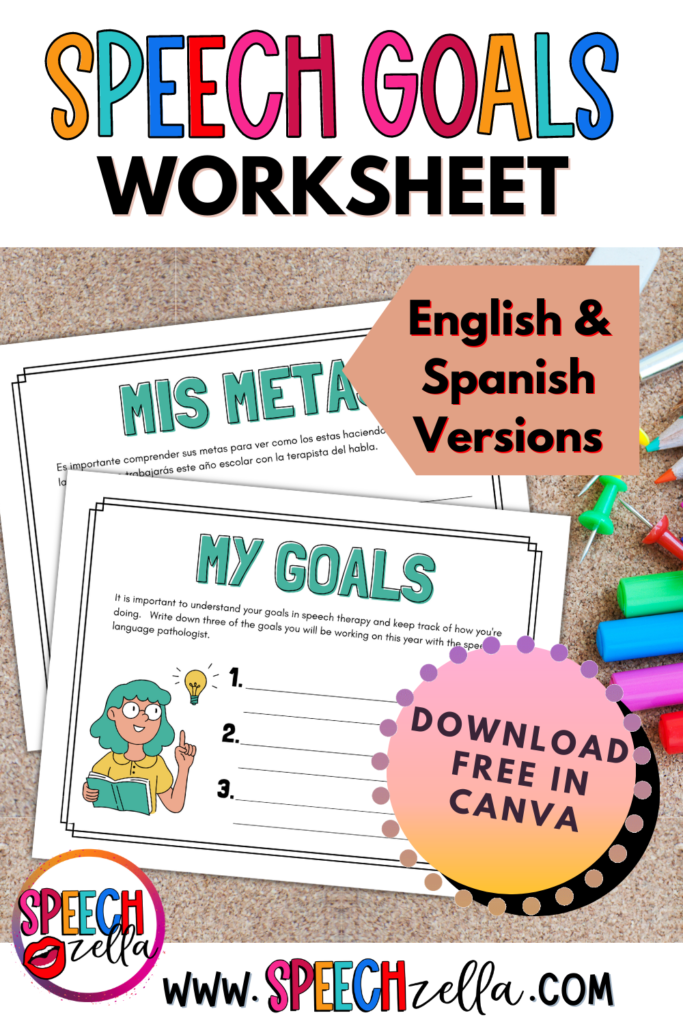
Syntax Speech Therapy Goals:
- Within 3 months, the student will improve expressive language skills by correctly using subject-verb agreement in sentences with 90% accuracy in structured language exercises as measured by informal assessments provided by the speech pathologist.
- By the end of the current IEP, the student will improve expressive language skills by increasing sentence complexity at least 50% of the time. The student will increase sentence complexity by using at least two prepositional phrases in their sentences during unstructured conversations with the speech pathologist.
- By the end of the school year, the student will correctly use possessive pronouns in structured conversations approximately 50% of the time, as measured during speech therapy sessions.
Vocabulary Speech Therapy Goals:
- By the end of the marking period, the student will increase their expressive vocabulary by practicing context clues to infer the meanings of unfamiliar words found in reading materials provided by the teacher. The student will correctly identify the meaning of these words approximately 60% of the time with moderate cues.
- By the end of 3 months, the student will improve their vocabulary skills by using the EET to describe unfamiliar vocabulary words with 50% accuracy when provided with moderate verbal and visual cues.
- By the end of the semester, the student will correctly identify 20 common objects with 50% accuracy when provided with moderate phonemic cues and provided with pictures of these common objects.
- Within 6 months, the student will improve their vocabulary skills by identifying vocabulary related to time and sequence approximately 60% of the time. The student will be provided with moderate cues and reading materials from the classroom teacher
Conclusion
Embrace creativity with Canva templates to streamline your work as a speech pathologist. These specially designed templates can be great data collection tools to track language development, social skills, and short story comprehension. There are so many more short-term objectives you can target with these templates, such as figurative language and main idea. By using these templates, you'll save time and provide your students with a more engaging and personalized learning experience. Take the first step towards a more productive and fulfilling speech therapy journey with Canva templates today!

